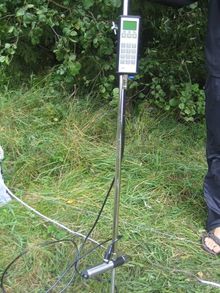Discharge - Ott ADC
Parameter to be measured:
Flow velocity (, discharge)
Method:
ultrasonic reflectogram cross-correlation
Equipment:
- probe
- display unit
- wading rod
Advantages:
- on-site discharge computation
- powerful quality checking, configuration and data storage options
- integrated depth measurement and sensor positioning indicator
- convenient software with visualisation capabilities
- USB (no serial port required)
- rechargable via USB
Disadvantages:
- heavy rods with coarse scale
- test device showed signs of rainwater entering the display
- built-in batteries, cannot be changed by user
What to watch out for:
- turbulent flow can cause the device to reject the measurements. Newer versions of the firmware provide (apart form additional quality check features) options to control that - look for new versions on the OTT-website
- back pain (when adjusting depth of the probe free-hanging) - use sliding rod or makeshift additional support for holding the rod
- the wall charger seems to use more than 12 V put on a standard mini-USB plug - rather don't try to charge standard devices with that power supply!
Links
Discharge - comparison of measurements (C2, Flowtracker, Flowsens, ADC, tracer, dipping rod)
Other related web sites:
Projects that used the above equipment: -
References
http://www.ott-hydrometry.de/web/ott_de.nsf/id/pa_adc_e.html
